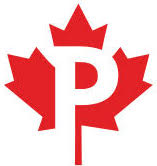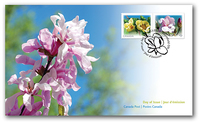
| Name | Value |
|---|---|
| Date of Issue | March 4, 2013 |
| Year | 2013 |
| Quantity | 7,320,000 |
| Denomination |
 PERMANENT™ (P). PERMANENT™ (P).Current monetary value: $0.92. |
| Perforation or Dimension | Simulated perforation |
| Series | Magnolias |
| Series Time Span | 2013 |
| Printer | Lowe-Martin |
| Postal Administration | Canada |
| Condition | Name | Avg Value |
|---|---|---|
|
M-NH-VF
|
Mint - Never Hinged - Very Fine | View price |
|
U-VF
|
Used - Very Fine | View price |
The hidden date for this stamp can be found on one of the Magnolia buds.








Is it the shyly opening cup of velvety petals? Or the intoxicating fragrance prized by luxury perfumers? For whatever reason, there’s something romantic and irresistibly exotic about magnolias.
While the very name of the flower can still conjure up visions of the South, complete with mint juleps and hoop-skirted belles, magnolias, originating in East and Southeast Asia, have adapted to climates in North America, Central America, the West Indies and South America. Hardy varieties, such as ‘Yellow Bird’ and ‘Eskimo’ featured on our stamps, and ‘Leonard Messel’ depicted on the Official First Day Cover, have been developed by hybridists to thrive in Canada’s cold winters and short summers.
Life before bees
Named after French botanist Pierre Magnol, the Magnolia genus comprises more than 200 flowering plant species in the subfamily Magnolioideae, part of the Magnoliaceae family. What’s truly fascinating about the magnolia is that it may be one of the oldest flowering plants on earth. Magnolia fossils believed to date back more than 20 million years have been found, and there is evidence that some plants of the Magnoliaceae family may have existed up to 95 million years ago. This delicate flower is so ancient, it evolved before bees existed, and botanists believe that the flowers were originally pollinated by beetles. This is why the magnolia’s carpels are so tough; the plant needed to adapt to a beetle’s rougher, clumsier touch.
The blooms we picked
Bright and saucy ‘Yellow Bird,’ so called for its sunny yellow colour, blooms in May, making it ideal for briefer Canadian summers. Closed, it’s reminiscent of a tulip waiting to bloom. ‘Eskimo,’ with its large cup flowers in white with a hint of lavender, is so hardy it can survive a mild frost. The bush-like plants of the ‘Leonard Messel’ produce 12-petal blooms that look like pale lilac-pink stars.
According to photographer and designer Isabelle Toussaint, “During my first trip to the Experimental Farm in Ottawa in May 2011, I photographed a wide variety of the typical white and pink magnolias. But this year, we wanted to show a less known variety of flower in the stamp duo. We learned that the rarer yellow magnolias would bloom two weeks later, so I made a second trip to photograph them on a beautiful sunny day. The choice was so vast that we could pick three more hybrids for the souvenir sheet, the OFDC and the inside of the booklet.”
She adds, “Since the magnolia is a tree and the flowers extend beyond the leaves, there was a bare effect, so I chose to keep the sky in the background, on both the stamps and the other collectibles.”
Stamp Design Manager Danielle Trottier has long wanted to celebrate the magnolia as part of this stamp series. “We have featured indigenous flower varieties and hybrids developed for the Canadian climate, and magnolias fall into the latter group. But a lot of Canadians would be surprised to learn how many varieties of this southern flower can flourish here. There’s an ‘I never knew that’ moment, a sense of discovering one more thing about our country. That’s what I wanted to do with these stamps. And of course, make them beautiful too.”
Note: Magnolias are courtesy of the Central Experimental Farm, Agriculture and Agri-Food Canada.